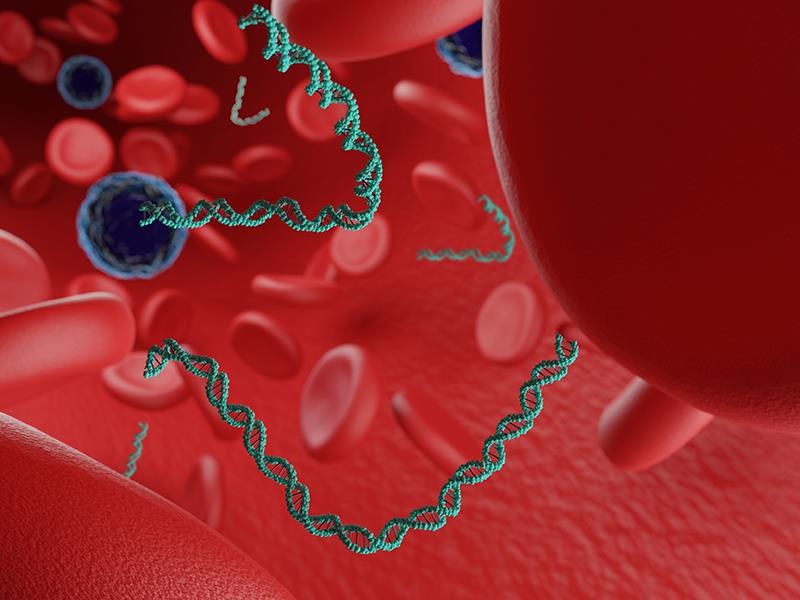ctDNA EGFRm helps pinpoint who benefits from 1L osimertinib-chemo combo





Detectable EGFR mutant (EGFRm) in plasma ctDNA prior to treatment may define a subgroup of patients with advanced EGFR-mutated non-small cell lung cancer (NSCLC) who would derive the most benefit from the addition of chemotherapy to first-line (1L) osimertinib, according to an exploratory analysis of the phase III FLAURA2 trial presented at AACR 2024.
In patients with detectable plasma EGFRm at baseline, the addition of platinum-pemetrexed to osimertinib significantly improved the median progression-free survival (PFS) by 10.9 months vs osimertinib alone (24.8 vs 13.9 months; hazard ratio [HR], 0.60, 95 percent confidence interval [CI], 0.45–0.80). [AACR 2024, abstract CT017]
In contrast, there was no significant extension in median PFS with the addition of platinum-pemetrexed in those with no detectable plasma EGFRm at baseline (33.3 vs 30.3 months; HR, 0.93, 95 percent CI, 0.51–1.72).
Data from FLAURA2 also sustain the concept that the detectability of plasma EGFRm at baseline, as well as on-treatment EGFRm clearance, has prognostic value. [Clin Cancer Res 2019;25:6644-6652; Clin Cancer Res 2023;29:3340-3351]
To add chemo or not?
FLAURA2 enrolled patients with locally advanced or metastatic non-squamous NSCLC characterized by EGFR exon 19 deletions (Ex19del) or the L858R point mutation, which were detected using an EGFRm tissue test.
In the primary analysis (n=557), the osimertinib-chemotherapy combination extended the median investigator-assessed PFS by 8.8 months vs osimertinib alone. This formed the basis for a new FDA-approved indication for osimertinib in February 2024. [N Engl J Med 2023;389:1935-1948]
One of the exploratory endpoints of FLAURA2 is to assess the correlation between plasma EGFRm (either Ex19del or L858R) detected at baseline and its clearance with PFS. This is of particular interest because weighing the pros and cons between single-agent osimertinib and osimertinib-chemotherapy involves considering the substantially higher incidence of grade ≥3 adverse events with the latter in FLAURA2 (27.3 percent vs 63.8 percent).
Of the 421 patients with evaluable baseline plasma ctDNA, the majority (73.2 percent) tested positive for plasma EGFRm at baseline.
In the pooled analysis, detectable plasma EGFRm at baseline significantly correlated with worse PFS. The median PFS was ≥1 year shorter among those with detectable plasma EGFRm at baseline vs those without (HR, 1.82, 95 percent CI, 1.37–2.38). This significant correlation held true regardless of whether the patient was being treated with osimertinib-chemotherapy or osimertinib alone, indicating that detectable plasma EGFRm at baseline confers a worse prognosis overall.
Plasma EGFRm dynamics
At week 3 of treatment, 81 percent and 71 percent of patients with detectable plasma EGFRm at baseline in the osimertinib-chemotherapy and the osimertinib alone arm, respectively, had plasma EGFRm clearance.
Unlike plasma EGFRm at baseline, on-treatment plasma EGFRm clearance did not predict the PFS benefits from osimertinib-chemotherapy vs osimertinib alone. The median PFS was significantly longer with the combination in patients with plasma EGFRm clearance at week 3 (27.6 vs 15.2 months; HR, 0.51, 95 percent CI, 0.35–0.75), and numerically 8.5-month longer in patients with no plasma EGFRm clearance (19.6 vs 11.1 months; HR, 0.62, 95 percent CI, 0.33–1.14).
“Osimertinib plus chemotherapy and osimertinib alone offered similar clinical benefit for patients without baseline-detected plasma EGFRm,” concluded Professor Pasi Jänne from the Dana-Farber Cancer Institute, Boston, Massachusetts, US. “Baseline detection of plasma EGFRm may identify a subgroup of patients who would derive most benefit from the addition of platinum-pemetrexed chemotherapy to osimertinib."